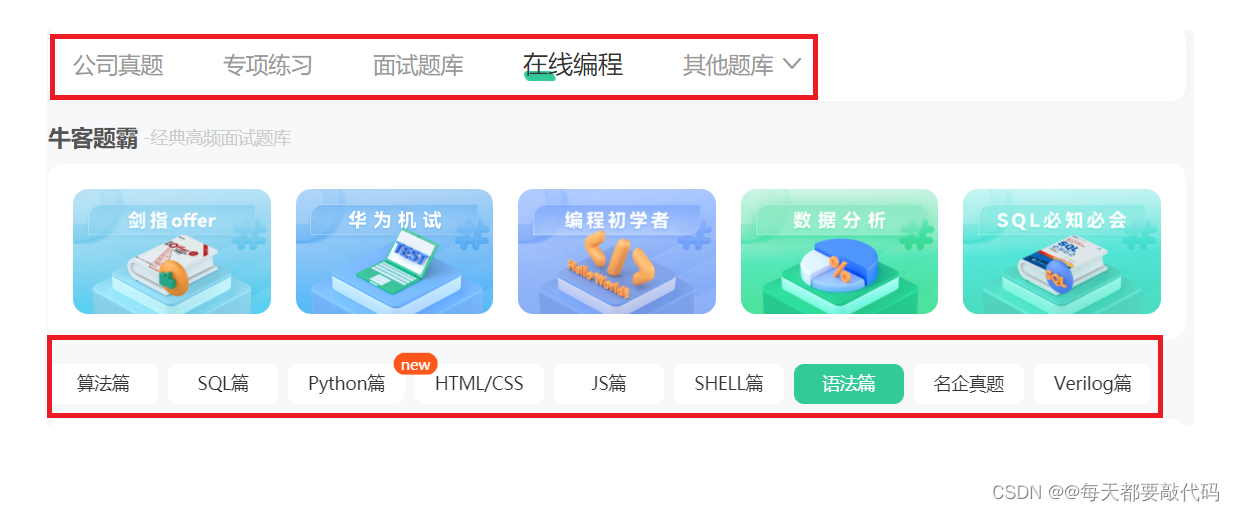泛型机制和增强for循环
✅作者简介:大家好我是@每天都要敲代码,一位材料转码农的选手,希望一起努力,一起进步!
📃个人主页:@每天都要敲代码的个人主页
💬推荐一款模拟面试、刷题神器,从基础到大厂面试题👉点击跳转刷题网站进行注册学习
目录
🥅初识泛型机制
🥅自定义泛型
🥅增强for循环(foreach)
🥅初识泛型机制
⭐️JDK5.0之后推出的新特性:泛型
⭐️泛型这种语法机制,只在程序编译阶段起作用,只是给编译器参考的(运行阶段泛型没用)
⭐️使用了泛型好处是什么?
第一:集合中存储的元素类型统一了。
第二:从集合中取出的元素类型是泛型指定的类型,不需要进行大量的“向下转型”!⭐️泛型的缺点是什么?
导致集合中存储的元素缺乏多样性!
❤️例1:泛型的用法
对于泛型就相当于范围缩小了,对于一个集合我们可以加进去任何类型的元素;当我们调用迭代器的next()方法时,取出来的类型实际上是Object类型;我们去调用类中的方法就需要向下转型;但是如果我们指定一个泛型的范围,就不需要向下转型,存取其它范围的类型就会报错!我们来通过一个例题感受一下吧!
package com.bjpowernode.javase.collection;import java.util.ArrayList;import java.util.Iterator;import java.util.List;public class GenericTest01 { public static void main(String[] args) { //1.不使用泛型 List mylist = new ArrayList(); //1.1.创建对象 Cat c = new Cat(); Bird b = new Bird(); //1.2.增加对象到集合当中 mylist.add(c); mylist.add(b); //1.3.获取迭代器,遍历集合调用move方法 Iterator it = mylist.iterator(); while(it.hasNext()){ // 取出来的对象默认是Object类型;Object里面没有move()方法 Object obj = it.next(); // 向下转型 if(obj instanceof Animal){ Animal animal = (Animal)obj; animal.move(); } } //2.使用泛型 // 使用泛型List之后,表示List集合中只允许存储Animal类型的数据。 // 用泛型来指定集合中存储的数据类型。 List mylist = new ArrayList(); //2.1.创建对象 Cat c = new Cat(); Bird b = new Bird(); //2.2.增加元素 mylist.add(c); mylist.add(b); //2.3.获取迭代器,遍历调用move方法 // 这个表示迭代器迭代的是Animal类型。 Iterator it = mylist.iterator(); while(it.hasNext()){ // 使用泛型,取出来的元素是Animal类型 Animal animal = it.next(); // 不需要向下转型,直接调用 animal.move(); // 但是调用子类中特有的方法还是需要向下转型,只是方便了一个环节 if(animal instanceof Cat){Cat cat = (Cat)animal;cat.catchMouse(); } if(animal instanceof Bird){Bird bird = (Bird)animal;bird.fly(); } } }}class Animal { // 父类自带方法 public void move(){ System.out.println("动物在移动!"); }}class Cat extends Animal { // 特有方法 public void catchMouse(){ System.out.println("猫抓老鼠!"); }}class Bird extends Animal { // 特有方法 public void fly(){ System.out.println("鸟儿在飞翔!"); }}❤️例2:自动类型推断
JDK8之后引入了:自动类型推断机制。(又称为钻石表达式)
package com.bjpowernode.javase.collection;import java.util.ArrayList;import java.util.Iterator;import java.util.List;public class GenericTest02 { public static void main(String[] args) { // ArrayList(),前提是JDK8之后才允许。 List myList = new ArrayList(); //自动类型推断 //添加对象到集合 myList.add(new Animal()); myList.add(new Cat()); myList.add(new Bird()); //遍历 Iterator iterator = myList.iterator(); while(iterator.hasNext()){ Animal an = iterator.next(); an.move(); } // 在比如:只存String类型的集合 List str = new ArrayList(); //自动类型推断 str.add("http://www.126.com"); str.add("http://www.baidu.com"); str.add("http://www.bjpowernode.com"); //str.add(new String(123)); //错误,类型不匹配 System.out.println(str.size()); //3 // 遍历 Iterator it2 = str.iterator(); while(it2.hasNext()){ // 如果没有使用泛型,还需要判断是不是一个String Object obj = it2.next(); if(obj instanceof String){ String ss = (String)obj; ss.substring(7); } // 使用泛型表达式,直接通过迭代器获取了String类型的数据 String s = it2.next(); // 直接调用String类的substring方法截取字符串。 String newString = s.substring(7); System.out.println(newString); } }}🥅自定义泛型
⭐️有了上面对泛型的理解,我们能让自己定义的类也具有泛型这种特性吗?下面让我们一起来自定义泛型!
⭐️自定义泛型的时候, 尖括号中的是一个标识符,随便写。
java源代码中经常出现的是:和
E是Element单词首字母。
T是Type单词首字母。
package com.bjpowernode.javase.collection;//自定义泛型public class GenericTest03 { //E只是标识符,随便写,一般写E或者T //提供一个方法,注意里面参数 public void doSome(E e){ System.out.println(e); } //程序入口 public static void main(String[] args) { //1、创建对象,假如这个方法只能调用用String类型 GenericTest03 gt = new GenericTest03(); //自动类型推断 //gt.doSome(10); //类型不匹配 gt.doSome("abc"); //这个方法传参只能跟String类型 // 创建对象,假如这个方法只能调用用Integer类型 GenericTest03 gt2 = new GenericTest03(); //gt2.doSome("abc"); //类型不匹配 gt2.doSome(100); //自动装箱 //2、定义一个方法,返回的类型要与类的泛型类型保持一致 MyIterator mt = new MyIterator(); String str = mt.get(); //返回类型只能是String MyIterator mt2 = new MyIterator(); Animal an = mt2.get(); //返回类型只能是Animal //3、定义了泛型我们不用,参数就是Object类型 GenericTest03 gt3 = new GenericTest03(); gt3.doSome(new Object()); //参数就是Object类型 }}class MyIterator{ public T get(){ return null; }}🥅增强for循环(foreach)
⭐️JDK5.0之后推出了一个新特性:叫做增强for循环,或者叫做foreach
⭐️我们已经学习了for循环,那么什么又是增强for循环呢?我们先看语法:
for(元素类型 变量名 : 数组或集合){ System.out.println(变量名);}⭐️增强for循环的缺点:没有下标!
package com.bjpowernode.javase.collection;public class ForEachTest01 { public static void main(String[] args) { // 1.定义一个数组 int[] arr = {22,3,9,5,6,8}; // 2.遍历打印(普通for循环) for (int i = 0; i < arr.length; i++) { System.out.println(arr[i]); } // 3.增强for循环 for(int i:arr){ // foreach有一个缺点:没有下标。在需要使用下标的循环中,不建议使用增强for循环。 // i就是数组中的元素(数组中的每一个元素) System.out.println(i); } }}❤️例:集合使用foreach
对于有下标的集合,我们现在就学到了三种打印方式:迭代器、利用下标、foreach
package com.bjpowernode.javase.collection;import java.util.*;//集合使用foreachpublic class ForEachTest02 { public static void main(String[] args) { // 创建List集合 List strList = new ArrayList(); // 增加元素 strList.add("hello"); strList.add("world"); strList.add("kitty"); //1. 遍历,使用迭代器 Iterator it = strList.iterator(); while(it.hasNext()){ System.out.print(it.next()+" "); } System.out.println(); //2. 使用下标方式 for (int i = 0; i < strList.size(); i++) { System.out.print(strList.get(i)+" "); } System.out.println(); //3. 使用foreach // 因为泛型使用的是String类型,所以是:String s for (String s:strList) { System.out.print(s+" "); } }}结束语
今天的分享就到这里啦!快快通过下方链接注册加入刷题大军吧!各种大厂面试真题在等你哦!
💬刷题神器,从基础到大厂面试题👉点击跳转刷题网站



